Located within the ‘earn’ tab of the Binance interface, Dual Investment is a product that allows individuals to potentially earn a high return on an investment of Bitcoin, Ethereum, Binance Coin, Solana, or Matic.
The product is not principal-guaranteed as many of the Binance earn products are; Individuals who subscribe to a specific target take the risk that their initial investment will decline in US dollar terms.
How does it work?
Dual investment involves two different digital currencies;
- A cryptocurrency that is not pegged to the value of $1, such as Bitcoin, and;
- A stablecoin that is pegged to $1 such as Tether (USDT) or Binance USD (BUSD).
There are two broad strategies offered, ‘sell-high’ and ‘buy-low.’ Sell-high enables you to pick the price at which you are willing to sell the cryptocurrency at a specific settlement date. Buy-low allows you to select the price you are willing to buy the cryptocurrency at a particular date.
Each product has an associated target price, annual percentage yield (‘APY’), and settlement date. An example of one such product is shown below for a sell-high strategy with Bitcoin:

In this example, for agreeing to sell Bitcoin deposited into the strategy for $31,000 BUSD on the 24th of May 2022, you will receive an annualised return of 41.91%.

For agreeing to buy Bitcoin for $28,000 USDT on the 24th of May 2022, you will receive an annualised return of 119.43%.
The catch with these products is that they only exercise if the price of Bitcoin is higher (in the case of the sell-high product) or lower (in the case of the buy-low product) than the target price at 16:00 (‘UTC’) on the settlement date.
This essentially means that (in the case of the first example) if the price of Bitcoin was lower than $31,000 on the 24th of May 2022, the product will not exercise, and you will receive your return in the form of Bitcoin. If the price of Bitcoin is higher than $28,000 on the 24th of May 2022 (in the case of the second example), the product will not exercise, and you will receive your return in the form of USDT.
What does this mean?
This product is described as a non-principal-guaranteed product because you take the risk of a loss in USD terms under either strategy whenever the price of Bitcoin drops significantly.
If you agree to sell Bitcoin at a specific price under the sell-high product and the Bitcoin price is considerably lower than the current price at settlement, you will receive more Bitcoin as a return, but said Bitcoin has depreciated in value.
The risk-return tradeoff within these products is very similar to the strategies of selling covered calls and selling cash covered puts:
Selling covered calls allows an investor to generate income off their holding (shares in a company, for example) by giving another investor the right (but not the obligation) to buy said holding at a specified strike price until a specified date. It is essentially giving up the opportunity to participate in a significant upward move for some income now.
Selling cash-covered puts allows an investor to give another party the right to sell their holding to them at a certain strike price by a specific date in return for premium. It is essentially selling someone insurance on their position by promising to buy it at the strike price no matter how low the holding goes.
Binance dual investment possesses these same elements but in a slightly different manner. With sell-high, an investor gives Binance the right to buy their cryptocurrency from them at the target price on the settlement date in return for a given APY. If Bitcoin is higher than the target price, Binance will take your Bitcoin and provide you with 1 Bitcoin worth of BUSD + interest. If Bitcoin is lower than the target price, Binance will return your Bitcoin to you and provide you with interest in the form of Bitcoin.
With buy-low, an investor gives Binance the right to sell them their Bitcoin at the target price on the settlement date for a given APY. If Bitcoin is lower than the target price, Binance will sell you their Bitcoin at the target price plus a return in Bitcoin. If Bitcoin is higher than the target price, Binance will not sell you the Bitcoin but provide your return in USDT.
With sell-high, Binance wins if the Bitcoin price appreciates significantly past the target price.
With buy-low, Binance wins if the Bitcoin price depreciates significantly past the target price.
Examples of single and combined strategies
Sell-high:
Firstly, let us look at the return profile for committing 1 BTC (worth $29,358 at the time) into a sell-high product with a $30,000 target price, paying an advertised 138% APY with settlement in 7 days.
With this product, we have three main scenarios that can occur.
1. Bitcoin rises to $32,000 by the settlement date.
In this scenario, the contract is exercised on settlement, and the 1 BTC is sold for $30,000 BUSD. In addition to the $30,000, the investor receives $1,438 BUSD in interest from the product, a return of 4.9%.
The return is calculated as ((Subscription amount (1) x Target price ($30,000)) x ((1 + APY (1.38)) x Deposit days (7) / 365).
In this scenario, the investor has foregone the opportunity to sell BTC at $32,000, which would have resulted in a profit of 9% or $2642.
2. Bitcoin rises to $30,001 by the settlement date.
In this scenario, similarly to scenario 1, the contract is exercised and the 1 BTC is sold for $30,000 BUSD with $1,438 BUSD in interest (a 4.9%) return.
Holding Bitcoin would have given a return of 2.19%.
3. Bitcoin is lower than $30,000 by the settlement date.
At any price lower than $30,000, the product is not exercised, and the investor receives their return in BTC.
The investor receives 1 BTC + 0.0266 BTC in interest. The investor will receive a positive return in USD terms if Bitcoin closes above $28,599. If Bitcoin closes at 90% and 80% of the target price at settlement, the USD value return will be -5.59% and -16.08%, respectively.
As we can see, the sell-high product has a dynamic where the upside is capped (in the case of this product to 4.9%) while slightly decreasing the downside (although there is still the risk of a 100% loss if Bitcoin were to drop to $0).
Figure 1: Showing the return of the product for a given strike price:
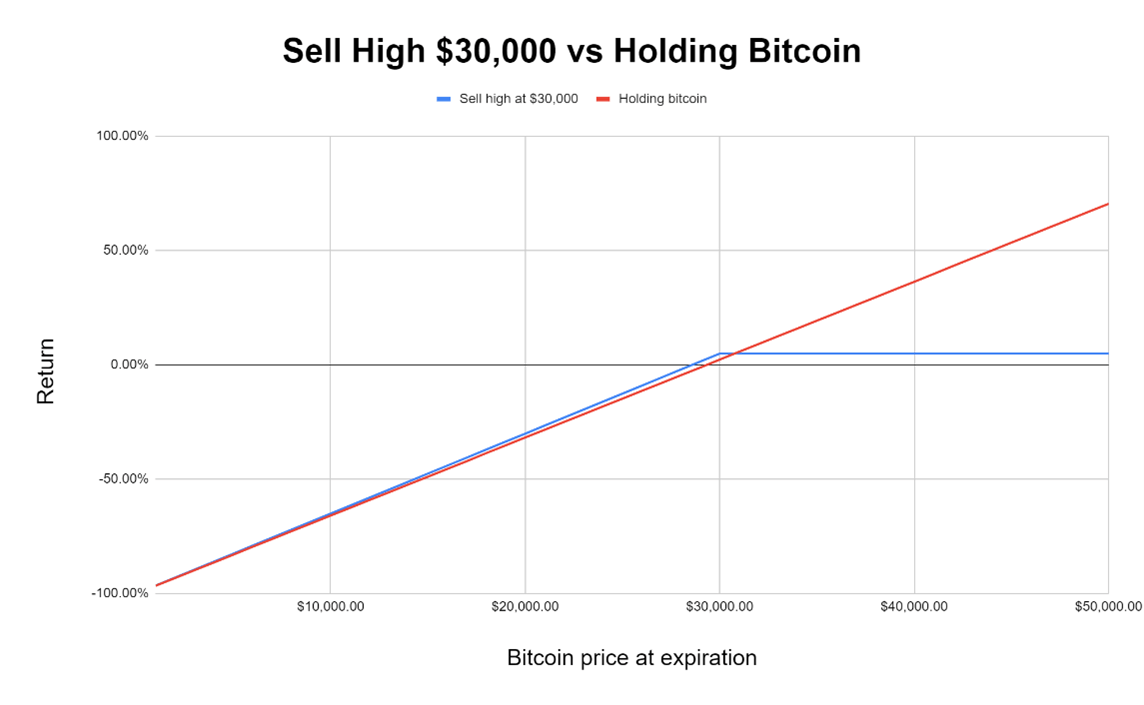
Figure 2: A zoomed in look at the return from $25,000 to $35,000. At $28,599 and above there is a positive return.

Buy-low:
Secondly, let’s look at the return profile for committing $30,352 USDT into a buy-low product with a $23,000 target price, paying an advertised 50.74% APY with settlement in 7 days.
Once again, we have three main scenarios that can occur.
1. Bitcoin is above $23,000 on the settlement date.
In this scenario, the contract is not exercised on settlement, and the investor receives $30,352 + $295.35 of interest, equating to a return of 0.97%.
2. Bitcoin is slightly below $23,000 on the settlement date.
In this scenario, the contract is exercised on settlement, and the investor receives 1 BTC + 0.2 BTC interest for a return of -0.04% in USD terms.
3. Bitcoin is significantly down by the settlement date (at $20,400).
If Bitcoin were to drop to 20% below the target price, the investor would receive 1 BTC + 0.2 BTC interest for a return of -19.22% in USD terms.
Figure 3: Showing the return of the product for a given strike price:
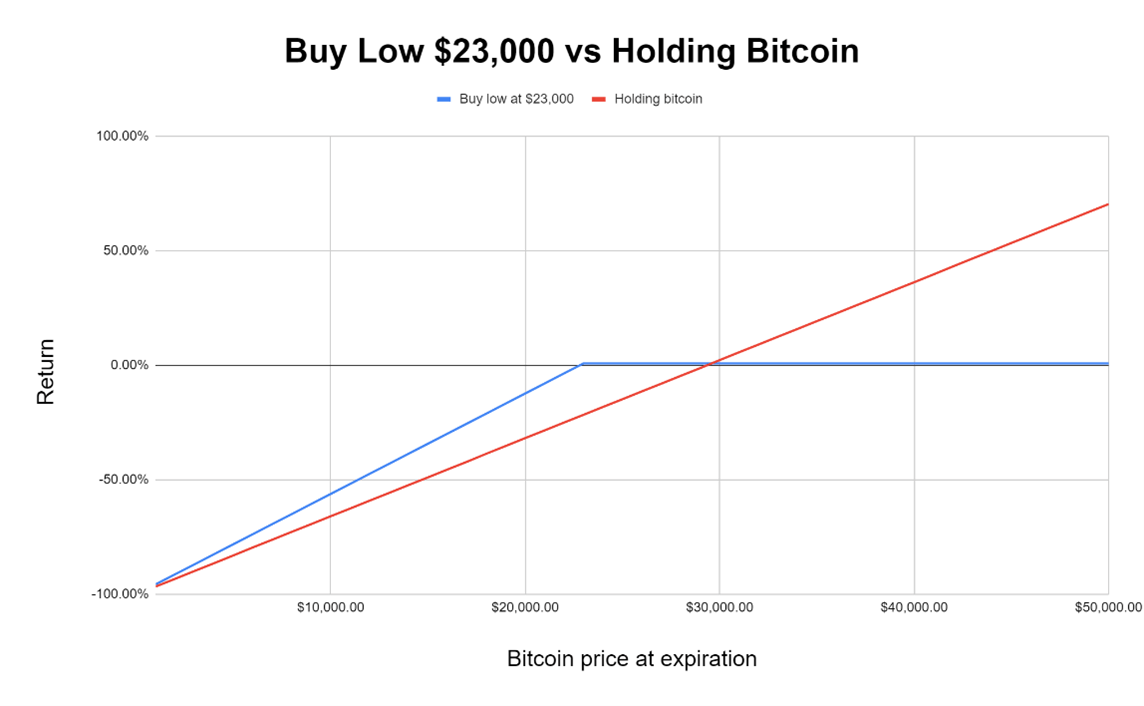
Figure 4: A zoomed in look at the return from $20,000 to $30,000. At $22,779 and above there is a positive return.
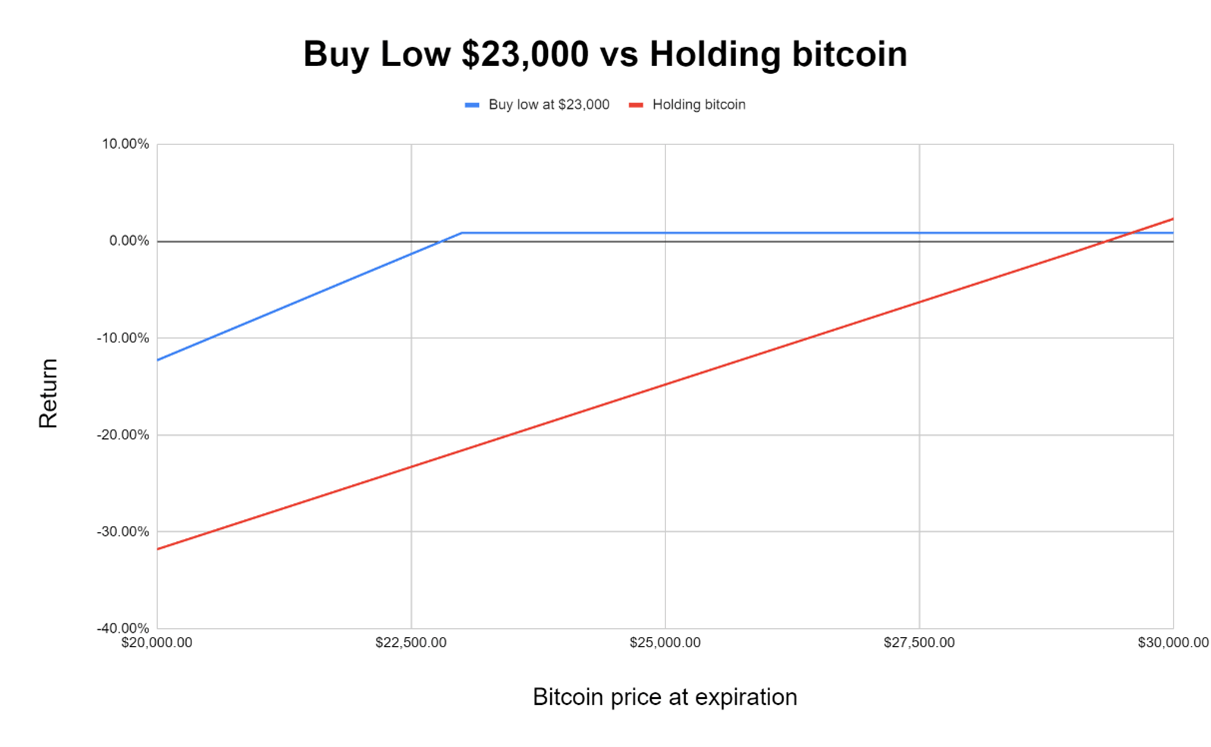
Combining the products:
The sell-high product acts as a covered call position while the buy-low product acts as a cash covered put. When the two products are subscribed to, the position serves as a covered combination trade, seeking to generate income while slightly hedging against a downside move in the cryptocurrency price.
Figure 5: Showing the return when combining sell-high (50%) and buy-low (50%) for a given target price:

Figure 6: A zoomed in look at the return from $25,000 to $35,000. At $28,500 and above there is a positive return.
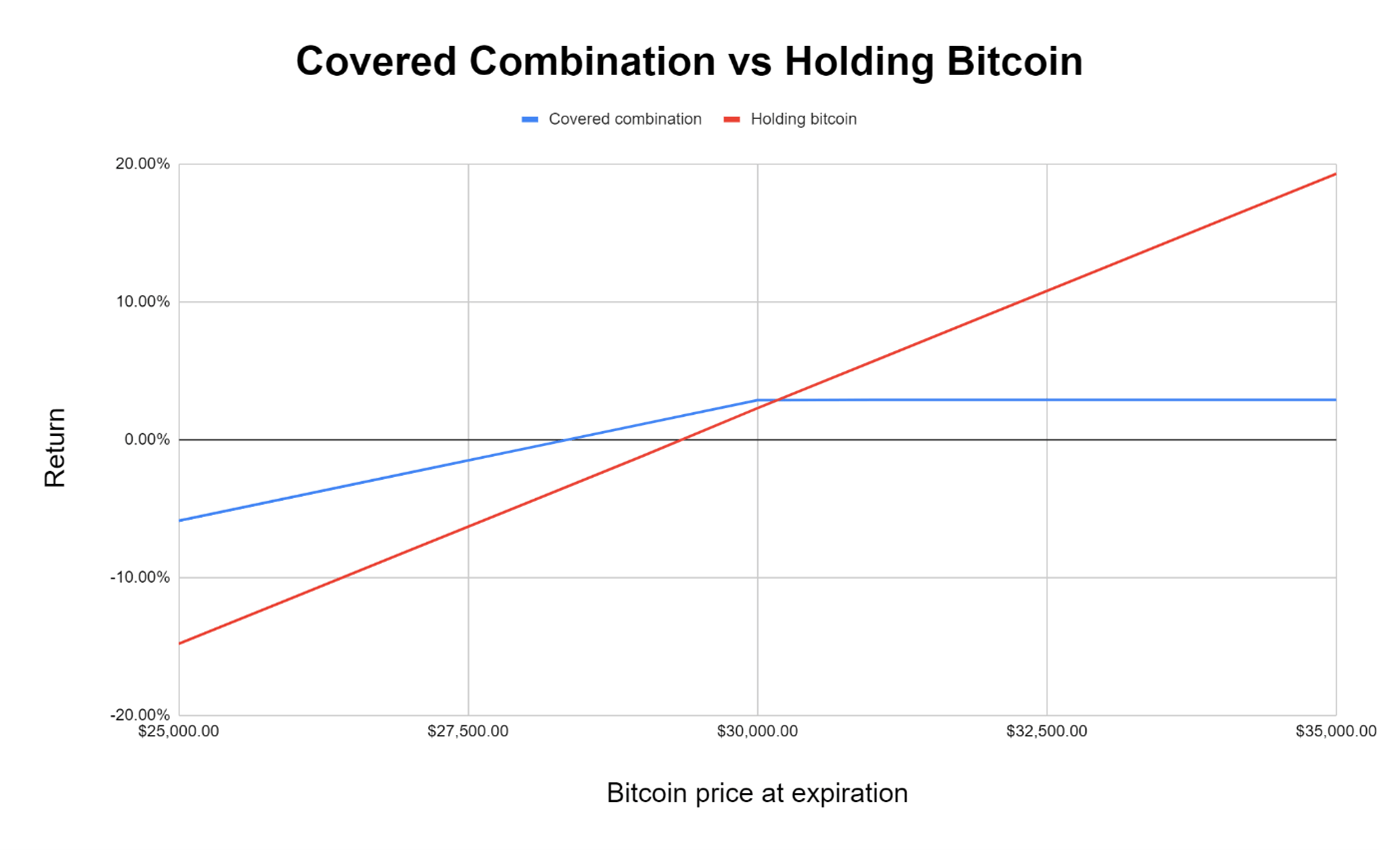
Figure 7: Comparing each of the strategies:

Figure 8: A comparison of the strategies from $20,000 to $35,000.
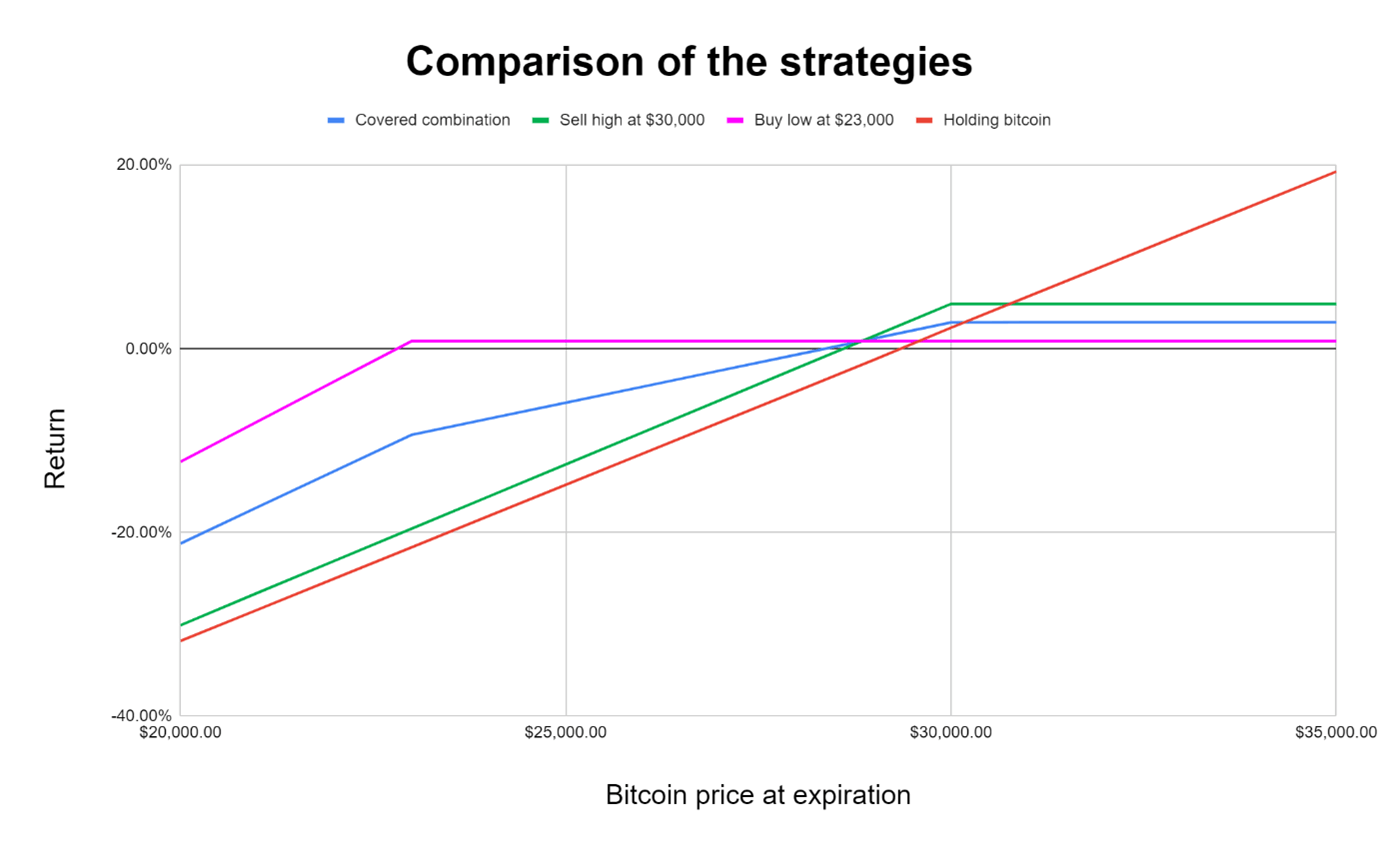
As shown in figure 8, the covered combination strategy sacrifices some of the upside from the sell-high product to reduce the potential loss from a drop in Bitcoin’s price. The ability to hedge from price declines is most significant at a Bitcoin price of $23,000. At this price, the covered combination will experience a loss of -9.36% compared to a loss of -21.6% from simply holding Bitcoin.
An investor can alter this risk-reward dynamic further by adjusting the percentage of capital allocated between sell-high and buy-low. Allocating more funds to sell-high will increase the upside potential while increasing downside potential and vice versa where allocating a higher proportion to buy-low.
Wrapping up
Binance’s dual investment products allow an individual investor to fairly easily enter into option-like positions with high potential APY’s while slightly hedging the downside exposure. The sell-high product is ideal for investors looking to exit a cryptocurrency position at a specific price and collect extra income. In contrast, the buy-low product is powerful for potentially entering into a cryptocurrency position while collecting extra income.
While the returns can be quite high for subscribing to near-dated products with target prices close to the current cryptocurrency price, it should be noted that there is the potential for significant losses should the cryptocurrency experience a large drop.
On the other hand, there is the potential to miss out on significant gains from holding a cryptocurrency should prices increase significantly within a short period of time.
Alternative cryptocurrency exchanges such as Huobi, OKX and Gate.io also offer products similar to Binance’s dual investments.
This article does not constitute appropriate financial advice, it simply explains the products, discussing the risk-return dynamic. Investors should conduct their own due diligence into any financial product they subscribe to and should understand the potential risks.
The information in this post is provided for information purpose only. It does not constitute any offer, recommendation or solicitation to any person to enter into any transaction or adopt any hedging, trading or investment strategy, nor does it constitute any prediction of likely future movement in rates or prices or any representation that any such future movements will not exceed those shown in any illustration. Users of this document should seek advice regarding the appropriateness of investing in any securities, financial instruments or investment strategies referred to on this document and should understand that statements regarding future prospects may not be realised. Opinion, Projections and estimates are subject to change without notice.
Greythorn Asset Management is not an investment adviser and is not purporting to provide you with investment, legal or tax advice. Greythorn Asset Management accepts no liability and will not be liable for any loss or damage arising directly or indirectly (including special, incidental or consequential loss or damage) from your use of this document, howsoever arising, and including any loss, damage or expense arising from, but not limited to, any defect, error, imperfection, fault, mistake or inaccuracy with this document, its contents or associated services, or due to any unavailability of the document or any thereof or due to any contents or associated services




